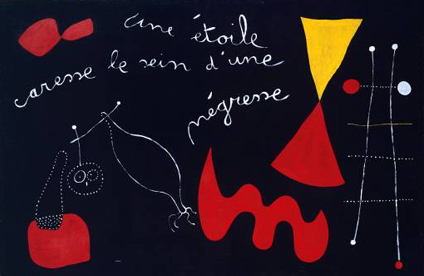APART FROM providing one of his more expansively surreal titles, Joan Miro's Half Brunette Half Red-headed Girl Slipping on the Blood of Frozen Hyacinths on a Blazing Football Field signals the artist's determination to respond - however circuitously - to desperate times. It is an abrupt, coarse-textured work, in which Miro's characteristic stick-figures and chirpy, effervescently metamorphic creatures have given up their past frolics and become enmeshed in grim, ugly conflict.
A gaggle of Miro biomorphs watch, helpless and amazed, while what you take for the girl of the title - a sort of daddy-long-legs with human characteristics - does the splits and is simultaneously assailed by a large black blob. Even the patchy white ground is a far cry from the consoling, limitless expanses, the vibrant fields of pure colour, that were Miro's characteristic mise-en-scene just a decade earlier.
Miro painted the picture in 1937, the same year in which he and his fellow Catalan Picasso drew inter-national attention to the atrocities of the Spanish Civil War - Picasso with Guernica, Miro with a lost mural called The Reaper - at the Spanish Pavilion of the International Exhibition in Paris. In the same year, Miro wrote that 'everything that is happening in Spain is terrifying in a way that you could never imagine . . . we are living through a hideous drama that will leave deep marks on our minds.'
It left deep marks, too, on his canvases, to judge by 'Joan Miro: 1929-41', at the Whitechapel. Among other things, this survey of mid-period Miro testifies to his willingness to depart from the precedents he had set himself. Previously, the now-familiar creatures of Miro's invented bestiary - the friendly, bewhiskered squiggles, the animated vegetation, the wriggling hairs - danced to the rhythms of a beneficent,...

Catalan Graffiti
07-02-1989

